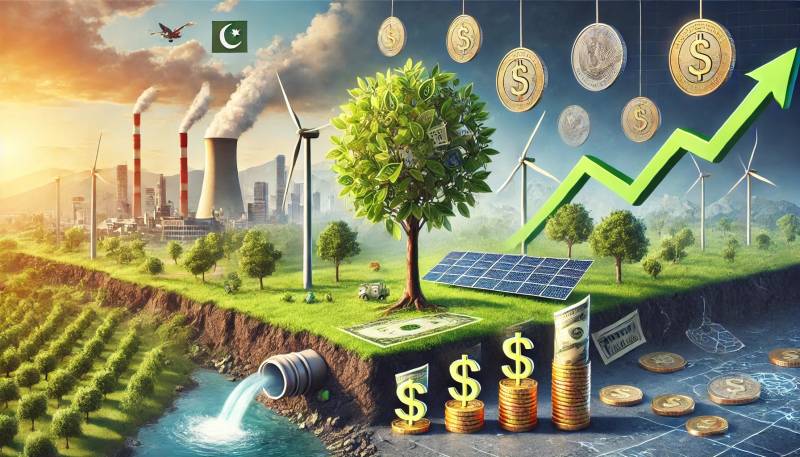
Climate finance is indispensable for nations striving to mitigate and adapt to climate change. As a developing country and highly vulnerable to environmental shocks, Pakistan has taken several measures to mobilise financial resources for climate action. A key step in this direction was the submission of its Nationally Determined Contributions (NDC) document to the UNFCCC in 2021, outlining its commitments to reducing greenhouse gas (GHG) emissions and the substantial financial inflows required to achieve these objectives.
Despite these commitments, Pakistan has struggled to secure substantial climate funding. To date, only two projects have been approved under the Adaptation Fund (Kyoto Protocol), ten by the Green Climate Fund (GCF), and 15 out of 19 proposals by the Global Environment Facility (GEF). As of 2025, GCF has sanctioned projects worth approximately $16 billion globally, yet Pakistan received a modest $304 million for ten projects through intermediary funding from institutions such as UNDP, ADB, FAO, JS Bank, Acumen, IFC, NRSP and WWF. A comparative analysis of GCF allocations across the region reveals that Pakistan lags behind its peer counterparts, Bangladesh and India. They have secured significantly higher funding due to their strong policy frameworks, commitment to climate concerns, and well-established institutional mechanisms. India saw the most notable increase in climate financing, receiving $804 million in GCF funds, while Bangladesh also obtained $441 million.
Bangladesh has strategically leveraged domestic resources through initiatives such as the Bangladesh Climate Change Trust Fund and the Country Investment Plan for Environment, Forestry, and Climate Change. These frameworks have effectively positioned Bangladesh to attract international climate investments. India’s private sector has played a critical role in driving down costs associated with carbon capture, green hydrogen, and battery storage solutions, further reinforcing its climate financing ecosystem. In contrast, Pakistan grapples with hurdles such as weak policy coherence, insufficient resource allocation, and an inability to formulate competitive funding proposals.
The year 2022 has brought about catastrophic climate-induced disasters in Pakistan, including scorching heat waves and unprecedented flash floods that caused immense loss and damage
Pakistan has taken steps towards green financing, with WAPDA successfully raising $500 million through 10-year Green Bonds to fund hydro-energy projects. Additionally, the Securities and Exchange Commission of Pakistan (SECP) has approved national guidelines for green bonds. In 2017, the State Bank of Pakistan (SBP) endorsed green banking guidelines and committed to establishing a comprehensive risk management framework. A dedicated steering committee—comprising SBP, IFC, and the Pakistan Banks’ Association—was formed to oversee progress. Furthermore, Pakistan has participated in the Clean Development Mechanism (CDM) to curb GHG emissions, though its engagement remains limited. The registration of CDM projects peaked in 2013 before experiencing a sharp decline. By September 2012, Pakistan had registered only 18 renewable energy projects, generating an annual 1.4 million Certified Emission Reductions (CERs). In contrast, China, India, and South Korea secured a dominant share of CERs, accounting for 60%, 15%, and 9%, respectively.
Pakistan’s commitments to the World Bank in climate finance are noteworthy, particularly in Climate Co-Benefits (CCBs). According to the NDC 2021 document, in FY21, Pakistan achieved a total of $1.6 billion in CCBs, representing 44% of the $3.6 billion in IDA/IBRD financing approved for the country. Of this, 61% was allocated to mitigation measures, while 39% was directed towards adaptation initiatives. However, a deeper structural alignment is required to optimise these commitments.
The year 2022 has brought about catastrophic climate-induced disasters in Pakistan, including scorching heat waves and unprecedented flash floods that caused immense loss and damage. The floods alone are estimated to have incurred a staggering cost of $30 billion, refocusing global attention on the pressing issue of climate change. A marathon session at the end of the UN conference—COP27—resulted in the approval of a Loss & Damage Fund (LDF). However, to access already available international funds and make the most of LDF, Pakistan needs to develop a team of highly trained professionals and a well-defined planning process to make sure that the pledges can be realised.
Private sector engagement is imperative to bridge the financing gap. Pakistan is currently exploring nature-based solutions and mitigation outcome transfers under Article 6 of the Paris Agreement, facilitating private investment in emission reduction. Additionally, the Public-Private Partnership Authority (PPPA) has the potential to streamline funding channels for implementing NDCs and expanding access to GCF resources. The Ministry of Climate Change (MoCC) has secured direct access to climate finance by accrediting JS Bank and the National Rural Support Programme (NRSP) as National Implementing Entities.
However, despite these efforts, climate financing remains a secondary priority in Pakistan’s economic policies, primarily due to institutional inefficiencies. The lack of policy coherence between the Ministry of Energy (MoE) and the MoCC has further exacerbated financing constraints. Additionally, Pakistan suffers from an inadequate climate data ecosystem, hindering the formulation of localised climate finance schemes. The private sector remains hesitant to invest in green technologies due to inconsistent policies, insufficient incentives, and an unpredictable regulatory environment.
To fully leverage climate finance, Pakistan must enact policy reforms, strengthen institutions, and create a more investor-friendly environment. The upcoming NDC 3.0 must address these challenges by integrating stronger policy, enhancing financial mechanisms and private sector engagement to ensure that climate commitments translate into tangible outcomes. Discussions under the IMF’s Resilience and Sustainability Facility (RSF) are currently underway, focusing on integrating climate finance into Pakistan’s macroeconomic framework. Key negotiations include a proposed carbon levy for FY 2025-26. Talks may also cover policies on electric vehicles, climate-related subsidies, and environmental initiatives. Addressing this is crucial for Pakistan to secure sustainable funding.

